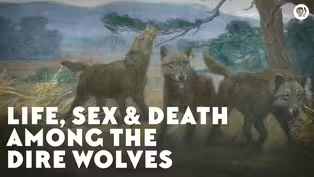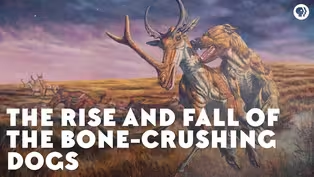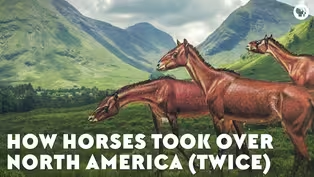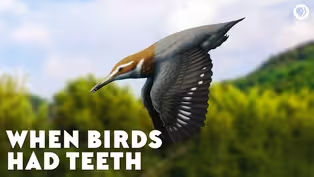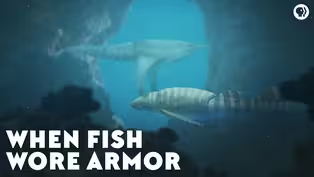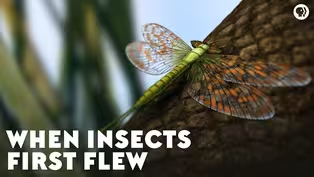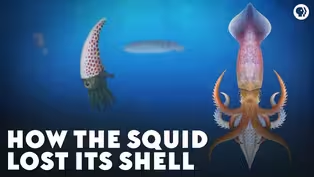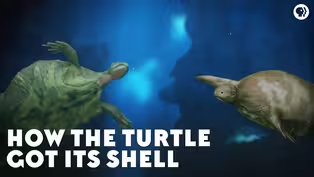
When Giant Scorpions Swarmed the Seas
Season 2 Episode 17 | 11m 38sVideo has Closed Captions
Sea scorpions thrived for 200 million years, coming in a wide variety of shapes and sizes.
Sea scorpions thrived for 200 million years, coming in a wide variety of shapes and sizes. Over time, they developed a number of adaptations--from crushing claws to flattened tails for swimming. And some of them adapted by getting so big that they still hold the record as the largest arthropods of all time.
Problems playing video? | Closed Captioning Feedback
Problems playing video? | Closed Captioning Feedback

When Giant Scorpions Swarmed the Seas
Season 2 Episode 17 | 11m 38sVideo has Closed Captions
Sea scorpions thrived for 200 million years, coming in a wide variety of shapes and sizes. Over time, they developed a number of adaptations--from crushing claws to flattened tails for swimming. And some of them adapted by getting so big that they still hold the record as the largest arthropods of all time.
Problems playing video? | Closed Captioning Feedback
How to Watch Eons
Eons is available to stream on pbs.org and the free PBS App, available on iPhone, Apple TV, Android TV, Android smartphones, Amazon Fire TV, Amazon Fire Tablet, Roku, Samsung Smart TV, and Vizio.
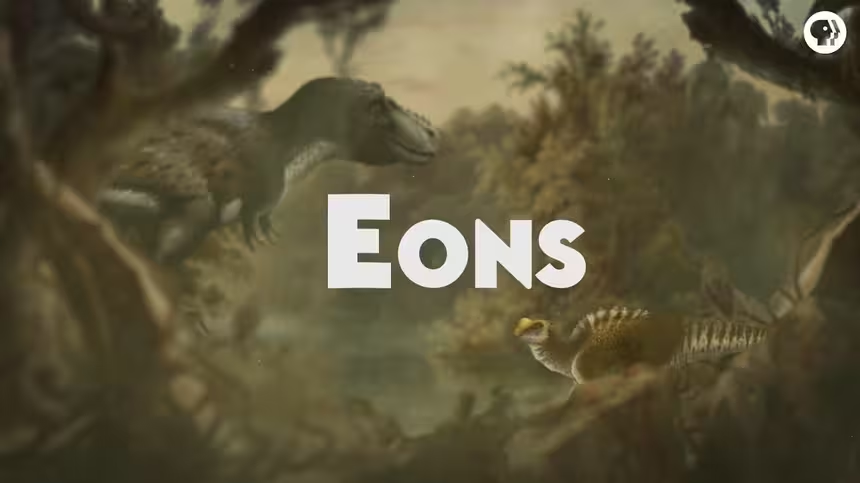
Welcome to Eons!
Join hosts Michelle Barboza-Ramirez, Kallie Moore, and Blake de Pastino as they take you on a journey through the history of life on Earth. From the dawn of life in the Archaean Eon through the Mesozoic Era — the so-called “Age of Dinosaurs” -- right up to the end of the most recent Ice Age.Providing Support for PBS.org
Learn Moreabout PBS online sponsorshipMore from This Collection
Ancient Fauna, Flora & Fungi
Video has Closed Captions
A look at when Temnospondyls Amphibians existed for 210 million years (9m 51s)
Life, Sex & Death Among the Dire Wolves
Video has Closed Captions
Dire wolves were real! Their remains taught us a lot about how they lived. (9m 15s)
The Rise and Fall of the Bone-Crushing Dogs
Video has Closed Captions
What happened to the biggest dogs that ever lived? (8m 29s)
How Horses Took Over North America (Twice)
Video has Closed Captions
Horses vanished from North America for 10,000 years until a mammal brought them back. (9m 8s)
Video has Closed Captions
How did Archaeopteryx relate to today’s birds? Its teeth provide a major clue. (11m 29s)
Video has Closed Captions
420 million years ago, some fish wore armor – and it may have served a surprising purpose. (9m 37s)
Video has Closed Captions
Insects were the first animals to fly. Scientists are still working on how it happened. (8m 38s)
Video has Closed Captions
Before a group of fish could live on dry land, they acquired the ability to breathe air. (8m 40s)
Why Triassic Animals Were Just the Weirdest
Video has Closed Captions
Why the Triassic was full of creatures that look a lot like other, more modern species. (9m 7s)
Video has Closed Captions
Ancestors of cephalopods all had shells until it proved to be their biggest weakness. (8m 5s)
Video has Closed Captions
Where did turtles come from? And how did the they get their shells? (8m 29s)
Providing Support for PBS.org
Learn Moreabout PBS online sponsorshipSome 400 million years ago, in the early Devonian Period, the world was a very different place.
0:00:05.510,0:00:10.240 Sea levels were high, and the continents were surrounded by vast, shallow seas, full of 0:00:10.240,0:00:14.090 exotic creatures like rugose corals, crinoids, and jawless fish.
0:00:14.090,0:00:19.260 And in what’s now Utah, one such fish met an end that was as grim as it was typical.
0:00:19.260,0:00:24.270 The jawless fish, known as Lechriaspis, was killed by three distinct puncture wounds to 0:00:24.270,0:00:27.980 the head -- puncture wounds made by crushing claws.
0:00:27.980,0:00:33.480 The culprit was an apex predator that dominated the seas of the late Silurian and early Devonian: 0:00:33.480,0:00:34.969 the sea scorpion.
0:00:34.969,0:00:40.610 Sea scorpions thrived for 200 million years, coming in a wide variety of shapes and sizes, 0:00:40.610,0:00:45.809 from Alkenopterus, which was about the size of a paper clip, to the terrifying Jaekelopterus, 0:00:45.809,0:00:47.620 which was 2 and a half meters long!
0:00:47.620,0:00:51.899 But in time, these able hunters would meet some stiff competition.
0:00:51.899,0:00:56.780 In the Late Devonian, giant armored jawed fish -- the placoderms -- would come to dominate 0:00:56.780,0:01:01.339 these seas and force other ocean-dwellers to adapt, flee, or perish.
0:01:01.339,0:01:05.320 These formidable predators would give the period its nickname: The Age of Fish.
0:01:05.320,0:01:10.370 And as a result of this competition, sea scorpions would eventually diverge into two distinct 0:01:10.370,0:01:14.920 lineages, each with its own unique strategy for dealing with the rise of the fish.
0:01:14.920,0:01:19.990 They developed a number of adaptations -- from those crushing claws that snagged the hapless 0:01:19.990,0:01:25.730 Lechriapsis, to flattened tails for swimming, as well as primitive lungs and strange, filter-feeding 0:01:25.730,0:01:26.730 appendages.
0:01:26.730,0:01:31.950 And some of them adapted by getting so big that they still hold the record as the largest 0:01:31.950,0:01:32.950 arthropods of all time.
0:01:32.950,0:01:38.130 They would even make the giant, historic leap from the water onto dry land.
0:01:38.130,0:01:42.640 But unlike their other arthropod relatives that we share the world with today, for the 0:01:42.640,0:01:49.500 sea scorpions, that move would prove to be the beginning of the end.
0:01:49.500,0:01:53.909 Scientists know “sea scorpions” by their proper, more accurate but also somewhat less 0:01:53.909,0:01:55.670 cool name: eurypterids 0:01:55.670,0:02:00.979 And eurypterids probably aren’t ancestral to the arachnids we know as scorpions today.
0:02:00.979,0:02:05.670 Sea scorpions and true scorpions are actually sister clades that both belong to a Subphylum 0:02:05.670,0:02:10.639 known as Chelicerata, an ancient group of arthropods that first appeared in the oceans 0:02:10.639,0:02:12.069 of the Cambrian Period.
0:02:12.069,0:02:16.769 By the time the Silurian Period rolled around, tens of millions of years later, the two clades 0:02:16.769,0:02:21.280 had diverged, each adapting a different way of breathing that ultimately set them down 0:02:21.280,0:02:23.659 very different evolutionary paths.
0:02:23.659,0:02:27.889 In the lineage of true scorpions, external respiration organs called “book-gills” 0:02:27.889,0:02:30.560 were adapted into internal “book-lungs”.
0:02:30.560,0:02:34.889 These lungs allowed the ancestors of today’s arachnids to become some of the first animals 0:02:34.889,0:02:36.750 ever to colonize land.
0:02:36.750,0:02:41.330 Sea scorpions, meanwhile, retained their book-gills, which are similar to what horseshoe crabs 0:02:41.330,0:02:43.120 use to breathe today.
0:02:43.120,0:02:46.139 And this kept them dependent on water—mostly.
0:02:46.139,0:02:50.970 But they also developed a second respiratory system, known as a “kiemenplatten”, which 0:02:50.970,0:02:55.629 functioned as a rudimentary lung and allowed them to take short trips onto land.
0:02:55.629,0:02:59.709 Because of these features, some researchers believe that kiemenplatten allowed sea scorpions 0:02:59.709,0:03:04.010 to mate and lay their eggs on land, or even to develop an amphibious lifestyle.
0:03:04.010,0:03:09.099 But, as history would show, this adaptation would prove to be a limitation, as well as 0:03:09.099,0:03:10.099 an advantage.
0:03:10.099,0:03:16.840 In 2015, the earliest-known eurypterid, Pentecopterus decorahensis, was discovered rocks in Iowa 0:03:16.840,0:03:20.340 that date back 467 million years.
0:03:20.340,0:03:24.939 It had compound eyes, a two-section body, and six pairs of appendages.
0:03:24.939,0:03:28.980 The first pair, by the mouth, would have been used for feeding, while the other five were 0:03:28.980,0:03:30.680 used for moving around.
0:03:30.680,0:03:35.469 Sea scorpions would soon come to be defined by how they these appendages adapted, splitting 0:03:35.469,0:03:40.099 off into two distinct suborders with two very different evolutionary strategies.
0:03:40.099,0:03:43.060 The first suborder to appear was Stylonuria.
0:03:43.060,0:03:48.709 And its first known member appears just nine million years after Pentecopterus, in what’s 0:03:48.709,0:03:49.760 now Wales.
0:03:49.760,0:03:54.829 This species was a humble little water monster just under 20 centimeters long, and it scuttled 0:03:54.829,0:03:59.419 along on ten legs, scavenging for food at the bottom of the shallow seas.
0:03:59.419,0:04:04.489 Like all of the Stylonurines that would follow, Brachyopterus used its appendages for walking 0:04:04.489,0:04:09.329 and stuck to a strategy of scavenging and filter feeding on the seafloor, in order to 0:04:09.329,0:04:12.660 stay out of the way of fish, which were on the rise.
0:04:12.660,0:04:16.959 But, during the Late Ordovician, a second suborder of sea scorpion emerges in the fossil 0:04:16.959,0:04:18.660 record — the Eurytperina.
0:04:18.660,0:04:24.730 The earliest-known eurypterine is a little species dated to 445 million years ago, discovered 0:04:24.730,0:04:26.110 in the shales of South Africa.
0:04:26.110,0:04:30.790 And these sea scorpions had a pair of appendages that were more like paddles, which allowed 0:04:30.790,0:04:36.190 them to swim, a lifestyle that put them in direct competition with jawless fish and cephalopods.
0:04:36.190,0:04:40.161 The newfound mobility of this group allowed it to diversify throughout the Silurian, and 0:04:40.161,0:04:45.150 fast, as they were able to colonize new areas and take advantage of new niches.
0:04:45.150,0:04:50.070 Plus, by competing with fish and cephalopods, they put themselves under selective pressure, 0:04:50.070,0:04:53.290 and launched an evolutionary arms race with other swimmers.
0:04:53.290,0:04:58.760 This led to much greater diversity in this suborder, which is probably why 75% of all 0:04:58.760,0:05:04.040 known sea scorpion species -- and more than 95% of all the specimens ever found -- belong 0:05:04.040,0:05:05.040 to Eurypterina.
0:05:05.040,0:05:09.980 But as the Silurian gave way to the Devonian, a dangerous new competitive pressure entered 0:05:09.980,0:05:13.690 the seas — the armored, jawed fish known as the placoderms.
0:05:13.690,0:05:18.160 So, after reaching their peak diversity at the very start of the Devonian Period, the 0:05:18.160,0:05:23.030 number of Euryterine species begins to drop in the fossil record, likely because many 0:05:23.030,0:05:26.360 simply couldn’t compete with this new powerhouse predator.
0:05:26.360,0:05:31.390 But the eurypterines that did survive managed to stage a sort of evolutionary rally, getting 0:05:31.390,0:05:35.940 bigger, faster, and stronger in the Devonian to cope with seas filled with placoderms that 0:05:35.940,0:05:37.100 were doing the same.
0:05:37.100,0:05:41.760 So, we probably have placoderms to thank for the nightmare fuel that followed, a family 0:05:41.760,0:05:46.690 of giant eurypterines that persisted for nearly 40 million years.
0:05:46.690,0:05:48.090 These are known as the pterygotids.
0:05:48.090,0:05:53.560 They were some of the only sea scorpions to cross the open ocean, exploring the seas between 0:05:53.560,0:05:56.530 the continents of Euramerica and Gondwana.
0:05:56.530,0:06:00.840 And several aspects of their anatomy indicate that they were active, powerful predators.
0:06:00.840,0:06:05.820 They had thin, light-weight exoskeletons that helped them move faster, and flattened tails 0:06:05.820,0:06:09.110 called telsons that gave them extra swimming power.
0:06:09.110,0:06:14.570 Their eyes faced forward and had thousands of lenses, giving them keen eyesight for spotting 0:06:14.570,0:06:15.570 prey.
0:06:15.570,0:06:20.010 And they caught that prey with mouth appendages called chelicerae that ended in large, raptor-like 0:06:20.010,0:06:21.010 claws.
0:06:21.010,0:06:25.650 These claws were so robust that they often preserved better than the thin exoskeleton, 0:06:25.650,0:06:29.750 and sometimes they’re the only parts that remain in fossils of pterygotids.
0:06:29.750,0:06:34.640 Many pterygotids reached over 1 meter in length, but the king of them all was Jaekelopterus 0:06:34.640,0:06:39.380 — the largest arthropod that has ever lived, maxing out at 2.5 meters long.
0:06:39.380,0:06:45.280 It was described from a claw found in Germany in 2007 that’s nearly half-meter long, with 0:06:45.280,0:06:49.010 tooth-like serrations that are about the size of a tiger’s canine teeth!
0:06:49.010,0:06:54.030 But despite their best efforts, these invertebrates couldn’t keep up with placoderms, and eurypterines 0:06:54.030,0:06:58.810 lost over 50 percent of their diversity within the first 10 million years of the Devonian.
0:06:58.810,0:07:03.250 By the end of the Devonian, all of the giant marine eurypterines had gone extinct.
0:07:03.250,0:07:08.530 Only one swimming genus -- the tiny, widely dispersed Adelophthalmus -- remained.
0:07:08.530,0:07:13.830 But while the dramatic rise and fall of Eurypterina had been happening out at sea, the slow and 0:07:13.830,0:07:16.750 steady Stylonuria were still hanging on.
0:07:16.750,0:07:21.680 In contrast to their cousins the eurypterines, the stylonurines remained relatively unaffected 0:07:21.680,0:07:23.200 by the rise of the fish.
0:07:23.200,0:07:27.740 While the eurypterines were busy competing with fish, stylonurines moved inland, to brackish 0:07:27.740,0:07:32.260 and freshwater ecosystems where there were fewer placoderms and less competition.
0:07:32.260,0:07:37.830 By the time of the Carboniferous Period, about 360 million years ago, Gondwana and Euramerica 0:07:37.830,0:07:42.580 had come together, allowing the stylonurines to spread out over the new supercontinent.
0:07:42.580,0:07:47.690 Now, the Carboniferous is most famous for giant arthropods like 2 meter long millipedes 0:07:47.690,0:07:50.760 and griffenflies with wingspans larger than that of some birds.
0:07:50.760,0:07:55.690 But if you were to hang around the muddy banks of a river, you might just spot the last of 0:07:55.690,0:08:00.000 the giant sea scorpions — a big weirdo called Hibbertopterus.
0:08:00.000,0:08:03.840 This was a very different sort of creature from the swimming, predators that had come 0:08:03.840,0:08:04.840 before.
0:08:04.840,0:08:09.680 It was basically a big, tank-like roomba, slowly combing the sediment at the bottoms 0:08:09.680,0:08:14.120 and banks of swamps and rivers with spiny sweep-feeding appendages.
0:08:14.120,0:08:20.050 A big trackway discovered in Carboniferous rock in Scotland has been attributed to Hibbertopterus.
0:08:20.050,0:08:24.520 And these tracks suggest that, while it wasn’t as long as Jaekelopterus, it was probably 0:08:24.520,0:08:27.550 heavier, with thicker legs to support it on land.
0:08:27.550,0:08:33.479 Scientists don’t really know why hibbertopterus got so big, but the size increase was gradual, 0:08:33.479,0:08:37.910 indicating that it might have been to better adapt to the species’ new freshwater home.
0:08:37.910,0:08:42.640 That’s because chelicerates have blood that has a salinity similar to that of sea water.
0:08:42.640,0:08:47.770 So a larger body size and thicker exoskeleton would have helped insulate hibbertopterus, 0:08:47.770,0:08:52.430 to maintain its blood salinity in freshwater and even in the open air.
0:08:52.430,0:08:57.190 Hibbertopterus died out in the Carboniferous, but other Hibbertopterids persisted for millions 0:08:57.190,0:08:58.190 of years.
0:08:58.190,0:09:03.170 The final eurypterid, Campylocephalus permianus, disappeared at the end of the Permian Period, 0:09:03.170,0:09:05.920 during the biggest extinction event in Earth’s history.
0:09:05.920,0:09:10.580 The end-Permian extinction, also called The Great Dying, was probably triggered by massive 0:09:10.580,0:09:16.279 volcanic eruptions in Siberia that warmed the climate and killed off more than 96% of 0:09:16.279,0:09:20.060 marine species and 70% of species on land.
0:09:20.060,0:09:25.870 Campylocephalus was among the many casualties, and with its demise, the 210 million year 0:09:25.870,0:09:28.260 age of eurypterids was brought to an end.
0:09:28.260,0:09:32.870 While sea scorpions ultimately succumbed the evolutionary pressure of powerful new vertebrates 0:09:32.870,0:09:38.110 and mass extinction events, for a big window of time, they were the most fearsome and diverse 0:09:38.110,0:09:39.960 arthropods around.
0:09:39.960,0:09:44.720 And they show us how different evolutionary paths can have very different outcomes.
0:09:44.720,0:09:50.131 By laying low and avoiding competition, stylonurines stuck around millions of years longer, while 0:09:50.131,0:09:53.920 eurypterines were far more diverse and plentiful at their peak.
0:09:53.920,0:09:57.970 In the end, their undoing might have been their inability to fully colonize the next 0:09:57.970,0:10:03.090 frontier -- dry land, where there was less competition and many more niches to fill.
0:10:03.090,0:10:07.650 While the sea scorpions couldn’t make the transition, it was made successfully by the 0:10:07.650,0:10:09.960 eurypterids’ sister-group: the arachnids.
0:10:09.960,0:10:13.840 Maybe if they’d developed a way to leave the water sooner, sea scorpions would still 0:10:13.840,0:10:14.840 be around.
0:10:14.840,0:10:20.130 Today, just three classes of Chelicerata remain: On land, there are the arachnids, like spiders, 0:10:20.130,0:10:21.710 ticks, and true scorpions.
0:10:21.710,0:10:25.900 And in the seas there are the sea spiders and the primordial-looking horseshoe crabs 0:10:25.900,0:10:30.960 -- living reminders of the watery origin of the chelicerates and the reign of the sea 0:10:30.960,0:10:30.980 scorpions.


- Science and Nature

A documentary series capturing the resilient work of female land stewards across the United States.












Support for PBS provided by:


